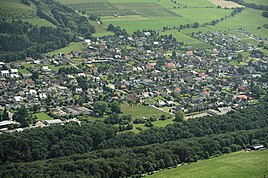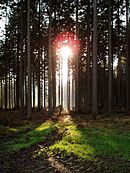Scharfenberg (Brilon)
|
Scharfenberg
City of Brilon
|
|
|---|---|
| Coordinates: 51 ° 25 ′ 33 ″ N , 8 ° 31 ′ 47 ″ E | |
| Height : | 432 m above sea level NN |
| Area : | 13.47 km² |
| Residents : | 1361 (Dec. 31, 2019) |
| Population density : | 101 inhabitants / km² |
| Incorporation : | 1st January 1975 |
| Postal code : | 59929 |
| Area code : | 02961 |
|
Location of the village of Scharfenberg within the urban area of Brilon
|
|
|
View of Scharfenberg
|
|
Scharfenberg is a district of the town of Brilon in the Hochsauerlandkreis , North Rhine-Westphalia ( Germany ). The village, which was independent until the end of 1974, had 1,361 inhabitants as of December 31, 2019, according to the city administration. This makes Scharfenberg the third largest district of the city of Brilon after Alme (1736) and Altenbüren (1365).
geography
Scharfenberg is located about four kilometers northwest of the city center on the streams Kloßsiepen and Höbecke, which merge northeast of the village into Bermecke , which in turn flows into the Möhne after about one kilometer. The Musenbecke, a tributary of the Glenne, rises to the southwest of the village . The valley floor of the mentioned brooks has an altitude of 413 m above sea level in the locality . NN up to 453 m above sea level NN .
The Sonder ( 552.5 m above sea level ), Riestental ( 516.3 m above sea level ) and Schälhorn ( 493 m above sea level ) mountains to the south and east of the village delimit the location from the Brilon plateau . To the north-west of the village there is an extensive forest that belongs to the eastern Arnsberg Forest . The highest point here is the Biberberg ( 484 m above sea level ).
history
Scharfenberg was originally a clustered village with very dense buildings around the church. There were hardly any house gardens beyond the courtyard, these were on the outskirts. In earlier centuries, as everywhere in the Sauerland, the life of the Scharfenbergers was determined by great poverty, famine, serious illnesses and early death. In addition, they were largely dependent on the noble landlord of the village, who owned almost all of the property. Only when this property was auctioned in 1835 by 67 Scharfenberg citizens (1000 acres of forest and almost 500 acres of land) and the later takeover by the municipality in 1853 did the economic situation gradually improve.
- 1306 Scharfenberg was mentioned for the first time in a document.
- In 1307 Scarpenberg Castle was first mentioned. It stood in the border area of the territories of the Prince-Bishops of Cologne and the Counts of Waldeck and was repeatedly destroyed in the constant territorial disputes on the border, for example in 1359, 1474 and 1695.
- On November 8, 1517, the Archbishop of Cologne, Morian von der Recke, enfeoffed Scharfenberg Castle as a fiefdom.
- In 1847 a fire destroyed the entire village, only 7 houses survived the fire. 73 houses with 11 extensions, 13 stables and 6 blacksmiths as well as mills burned down. The church, completed in 1746, burned to the ground. Three people died in the flames. Due to the police ordinance for the province of Westphalia, the new construction of the place required by the residents was only possible according to a building plan approved by the Royal Highly Commendable Government . The plan was drawn up by the Brilon master road builder, Plate, and enforced against the opposition of the population.
- In 1853 the community bought the property at auction as the 67 owners were unable to repay their debts due to the fire.
- In 1911 the parish bought another 800 acres of forest. It became one of the richest communities in the area after being one of the poorest 80 years earlier.
On April 2, 1945, a unit consisting of 150 Wehrmacht soldiers and 150 armed men from the Reich Labor Service , under the orders of a 23-year-old one-armed lieutenant, reached Scharfenberg. There was also a representative of the NSDAP Gauleitung. This immediately called the Volkssturm in Scharfenberg . These 60–70 men of the Volkssturm began building roadblocks towards Brilon and Rixen. The attack by US troops and under artillery fire protection began at 11:30 a.m. The Volkssturm men stopped building the roadblocks and fled to their families. Some farmers fled into the forest with carts. When a US tank gunner fell in the defensive fire, there was more massive shelling of the village. The German fighters now withdrew into the forest. Two German soldiers were killed in the village battle. The fallen were buried in the village cemetery and later reburied in the Böddecke military cemetery near Wewelsburg. Several buildings were damaged. On April 9, the US troops moved on. In the following weeks there were raids and looting of individual farms and the Scharfenberg train station by former prisoners.
In the Second World War , 51 Scharfenbergers died as soldiers, most of them on the Eastern Front , or died in captivity.
On January 1, 1975, Scharfenberg was incorporated into Brilon as part of the municipal regional reform .
politics
coat of arms

|
Blazon : In silver, a curved, rising, curly black tip covered with golden rust. Description: The coat of arms with the rising black tip is taken from the coat of arms of the noble family of the Weichs , to whom the place belonged for a long time. The grate is the symbol of St. Lawrence , the patron of the church. |
Attractions
- The St. Laurentius Church with the baroque spire , built in the years 1745–1750 according to plans by Franz Christoph Nagel in the baroque style , was not rebuilt in the style after the fire of 1847. The rococo furnishings include a pulpit, oak pews, St. Mary's altar, high altar and the organ from 1754 and the so-called branch cross dated from the 15th century , the type of which can only be found in the Rhineland-Westphalia region.
- The manor house of Freiherr Joseph Maria von Weichs near the church is worth seeing .
economy
In Scharfenberg there is a plastics company, a textile wholesaler and craft businesses in the building and finishing trades.
In the past Scharfenberg was known for its broom making.
Scharfenberger
- Franz Rinsche (Westphalian native and dialect poet)
literature
- Hugo Cramer: The district of Brilon in the Second World War 1939-1945 - reports from many employees from all over the district. Josefs-Druckerei, Bigge 1955.
- Wilfried Finke: Stories from Scharfenberg (for the 700th anniversary of the village)
- Franz Schrewe: Säu kuiert me bey us: Dictionary for the Low German language . Podszun, Scharfenberg 1997, ISBN 3-86133-187-X .
Web links
- Homepage of the place
- Scharfenberg (Brilon) in the Westphalia Culture Atlas
Individual evidence
- ↑ a b Population statistics December 31, 2019. (PDF) City of Brilon, accessed on April 24, 2020 (26 kB).
- ↑ Rudolf Kraft, Briloner Heimatbuch, Volume I, page 64
- ^ Alfred Bruns, inventory of the Brilon City Archives, inventory A, 1970, ed. from the State Office for Archive Maintenance, Verlag Aschendorff, Münster, p. 85.
- ^ Rudolf Kraft, Briloner Heimatbuch, Volume I, page 63
- ^ Hugo Cramer: The district of Brilon in the Second World War 1939-1945 . 1955, section Scharfenberg, pp. 64-65.
- ^ Hugo Cramer: The district of Brilon in the Second World War 1939-1945 . 1955, honor roll section Scharfenberg, pp. 244–245.
- ^ Federal Statistical Office (ed.): Historical municipality directory for the Federal Republic of Germany. Name, border and key number changes in municipalities, counties and administrative districts from May 27, 1970 to December 31, 1982 . W. Kohlhammer, Stuttgart / Mainz 1983, ISBN 3-17-003263-1 , p. 332 .
- ^ Eduard Belke, Alfred Bruns, Helmut Müller: Communal coats of arms of the Duchy of Westphalia, Arnsberg 1986, ISBN 3-87793-017-4










